This post contains affiliate links. See our Affiliate Disclosure Statement page for more details.
Table of Contents
How to Calm an Anxious Boxer Dog
Boxer dogs are known for their playful nature, loyalty, and boundless energy. However, Boxers can also be anxious based on certain situations and need effective strategies to calm them down.
It’s essential for Boxer owners to recognize the signs of anxiety and learn how to calm an anxious boxer dog.
In this article, we will explore the temperament of Boxer dogs, the various types of anxiety they may experience, and effective techniques to calm an anxious Boxer.
How to Calm an Anxious Boxer Dog – 7 Strategies
- Create a Safe, Comfortable Environment
- Maintain a Regular Routine
- Exercise and Mental Stimulation
- Use Positive Reinforcement Training
- Implement Relaxation Techniques
- Provide Socialization Opportunities
- Consult with a Veterinarian or Professional Trainer
How to Calm an Anxious Boxer Dog – Types of Anxiety
Before we discuss the 7 strategies for how to calm a boxer dog, it is important to understand the stressors causing anxiety and anxiousness.
Boxers like other dog breeds can experience anxiety based on certain stressors or situations. Boxers can become anxious when they experience the following types of anxiety. These include
How to Calm an Anxious Boxer Dog – 6 Types of Anxiety
- Separation Anxiety
- Boxers are known to form strong bonds with their owners, and when they are left alone, they may become anxious and distressed.
- This can lead to behaviors such as excessive barking, destructive chewing, house soiling, or attempts to escape.
- Noise Anxiety
- Boxers may be sensitive to loud noises such as thunderstorms, fireworks, or vacuum cleaners.
- They can exhibit signs of anxiety like panting, pacing, trembling, seeking comfort, or trying to hide.
- Social Anxiety
- Some Boxers may feel anxious or uncomfortable in social situations, particularly when encountering unfamiliar dogs or people.
- They may display signs of fear or aggression, such as growling, barking, or attempting to retreat.
- Generalized Anxiety
- Boxers, like humans, can experience general anxiety without any specific triggers.
- They may exhibit signs of restlessness, panting, excessive grooming, pacing, or compulsive behaviors.
- Travel Anxiety
- Boxers may feel anxious or stressed during car rides or when traveling.
- They may pant excessively, drool, whine, or show signs of restlessness.
- Medical Anxiety
- Boxers that have had negative experiences with veterinary visits or medical procedures in the past may develop anxiety related to medical environments.
- This can make it challenging for them to receive necessary veterinary care.
It’s important to note that anxiety in dogs can have various causes and may manifest differently in individual animals. If you suspect that your Boxer is experiencing anxiety, it’s recommended to consult with a veterinarian or a professional dog trainer who can provide further guidance and develop a suitable treatment plan.
Below is a summary table summarizing the 6 types of Boxer dog anxiety, a description, and signs and symptoms relating to each type of anxiety.
Table – Summary of 6 Types of Anxiety in Boxer Dogs
| Type of Anxiety | Description | Signs and Symptoms |
|---|---|---|
| Separation Anxiety | Anxiety when left alone or separated from the owner | Excessive barking, destructive behavior, house soiling, attempts to escape |
| Noise Anxiety | Anxiety triggered by loud noises or specific sounds | Panting, pacing, trembling, seeking comfort, hiding |
| Social Anxiety | Anxiety in social situations, especially with unfamiliar individuals or dogs | Fearful behavior, aggression (growling, barking), attempts to retreat |
| Generalized Anxiety | Overall anxious behavior not necessarily triggered by specific events or situations | Restlessness, panting, excessive grooming, pacing, compulsive behaviors |
| Travel Anxiety | Anxiety associated with traveling, especially in cars | Excessive panting, drooling, whining, restlessness |
| Medical Anxiety | Anxiety related to veterinary visits or medical procedures | Fearful behavior, reluctance to approach the vet or medical equipment |
For additional information on Do BBoxer Bark a lot, read our article – Do Boxers Bark A Lot? 4 Best Reasons Boxers Bark
How to Calm An Anxious Boxer Dog

Image by heathergunn from Pixabay
Now that we have a good understanding of the types of anxiety your Boxer dog may experience, the stressors causing the anxiety, and the signs and symptoms of anxiety, let’s focus on the strategies for how to calm an anxious Boxer dog.
7 Strategies for How to Calm An Anxious Boxer Dog
Create a Safe and Comfortable Environment
Creating a safe environment for Boxer dogs is crucial in reducing their anxiousness and promoting their overall well-being.
Boxers are known to be sensitive and prone to anxiety, so it’s important to address their specific needs to help them feel secure and comfortable. Below are detailed strategies for how to create a safe environment for how to calm an anxious Boxer dog.
- Provide a designated space
- Dedicate a specific area in your home where your Boxer dog can retreat to when they feel stressed or overwhelmed.
- This can be a crate, a cozy corner with a comfortable bed, or a room with their favorite toys and blankets.
- Having a designated space allows them to have a sense of security and a place to relax.
- Provide mental and physical stimulation
- Boxers are active and intelligent dogs that require both physical and mental stimulation.
- Lack of stimulation can lead to restlessness and anxiety.
- Ensure that your Boxer gets regular exercise through daily walks, playtime, and interactive toys.
- Mental stimulation, such as puzzle toys and obedience training, can also help keep their minds engaged and reduce anxiety.
- For additional information on Mental Stimulation for Boxers read our article: 9 Best Ways To Mentally Stimulate Your Boxer Dog for a Happy, Obedient Companion
- We use and recommend the Starmark Treat Dispensing Chew Ball Tough Dog Toy
- Try Soft Flex Paw-zzle Balls from Cherrybrook to help provide mental stimulation for your Boxer
- Offer a variety of interactive toys
- Providing your Boxer with a variety of interactive toys can be beneficial in reducing anxiety.
- Puzzle toys, treat-dispensing toys, and chew toys can help keep them occupied and redirect their attention from stressors.
- These toys also encourage problem-solving and mental engagement, which can have a calming effect on your Boxer.
- Visit PetCareRx for a variety of interactive toys to help calm your boxer. Use the link below to save on interactive toys.
- Save an Extra 25% OFF Sitewide + Enjoy Free Standard Shipping on orders $48+ only at PetCareRx.com! Use Code: CARE25
- Establish a calm environment
- Boxers are sensitive to their surroundings, so it’s essential to create a calm and soothing environment for them.
- Minimize exposure to loud noises, such as construction sounds or fireworks, as they can trigger anxiety.
- Use white noise machines or calming music to drown out external noises that may cause stress.
- Additionally, create a peaceful atmosphere by providing a soft, comfortable bed, and consider using pheromone diffusers that release calming scents like lavender or chamomile.
- Use positive reinforcement training
- Positive reinforcement training techniques can help build your Boxer’s confidence and reduce anxiety.
- Rewarding good behavior with treats, praise, or playtime reinforces positive associations and helps them feel secure.
- Avoid punishment-based training methods, as they can increase anxiety levels and undermine trust.
- Interested in training your Boxer, read our article – Are Boxer Dogs Easy To Train? We Tested Our Boxers Abilities To Uncover the Answer!
- For training a Boxer dog, we use and recommend Holly and Hugo’s Dog Socialization and Obedience Master Class
- Ensure a balanced diet
- A balanced and nutritious diet is essential for your Boxer’s overall health, including their mental well-being.
- Some dogs may benefit from foods that contain calming ingredients like chamomile or tryptophan.
- Proper nutrition can support a stable mood and contribute to reducing anxious behaviors.
- Seek professional help if necessary
- If your Boxer’s anxiety persists despite your best efforts, consider seeking professional help from a veterinarian or a certified dog behaviorist.
- They can provide specialized guidance and create a tailored plan to effectively address your dog’s anxiety.
- They may recommend behavior modification techniques, medications, or other interventions to help manage and reduce anxious behaviors.
Remember that each Boxer dog is unique, and what works for one may not work for another.
Be patient, observe your dog’s behavior closely, and make adjustments accordingly.
By creating a safe and supportive environment, you can help your Boxer feel secure, reduce their anxiousness, and promote their overall well-being.
Maintain a Regular Routine – How to Calm an Anxious Boxer Dog

Image by Myriams-Fotos from Pixabay
Creating a regular routine can significantly calm an anxious Boxer dog.
Boxers thrive on predictability and structure, and a consistent daily routine helps provide them with a sense of security and stability.
By establishing a set schedule for feeding, walking, playtime, and rest, you create a reliable environment that the dog can rely on.
The predictability of a routine reduces uncertainty and anxiety triggers, as the Boxer knows what to expect and when to expect it.
This stability helps the dog feel more at ease, as they can anticipate their needs being met consistently.
A regular routine ensures that the dog receives the necessary physical exercise and mental stimulation, which are vital for reducing anxiety.
By providing daily outlets for their energy and engaging their minds, the routine helps prevent restlessness and redirect anxious behavior.
Overall, a regular routine establishes a sense of order, meets the dog’s needs consistently, and promotes a calming environment that can greatly benefit an anxious Boxer dog.
Exercise and Mental Stimulation – How To Calm An Anxious Boxer Dog

Exercise and mental stimulation play crucial roles in reducing anxiety in Boxer dogs. Below are detailed activities can help with how to calm an anxious Boxer dog.
- Physical exercise
- Engaging your Boxer in daily exercise helps burn off excess energy and tension, which can contribute to reducing anxiety.
- Activities such as brisk walks, jogging, or playing fetch in a secure area allow your dog to release pent-up energy and promote relaxation.
- Regular exercise also promotes the production of endorphins, which are natural mood boosters, helping to reduce anxiety and promote a sense of calm.
- Fo additional Information on Exercise for Your Boxer Dog read our articles
- Boxer Dog Exercises – 3 Best Types Of Exercise From Boxer Puppy To Senior Boxer Dog
- 7 Best Common Calorie Burning Exercises For Boxer Dogs And Owners
- We recommend the Kong Flyers and ChuckIt Fumble Fetch
- For Jumping we recommend the Squishy Face Studio Flirt Pole V2 with Lure Squeaky Dog Toy
- Mental stimulation
- Boxers are intelligent dogs that need mental stimulation to keep their minds engaged.
- Boredom can lead to anxiety and destructive behaviors.
- Providing mental challenges through interactive toys, puzzle feeders, and obedience training sessions can help redirect their focus and alleviate anxiety.
- These activities encourage problem-solving and engage their cognitive abilities, giving them a sense of accomplishment and satisfaction.
- Mental stimulation also helps prevent the development of anxious habits by redirecting their attention away from stressors and promoting a more positive and focused mindset.
- Training and obedience
- Regular training sessions not only teach your Boxer important skills but also provide mental stimulation and promote a bond between you and your dog.
- Positive reinforcement training techniques, such as reward-based training, help boost your dog’s confidence and self-esteem.
- This can be particularly beneficial for anxious Boxers, as it helps build their trust and redirects their focus from anxiety-inducing situations.
- Training sessions also provide structure and predictability, which can help alleviate anxiety by establishing clear communication and expectations.
- We use and recommend Hugo and Holly’s Rewards-Based Dog Training
- For Interactive online training visit Rover.com –
- Rover.com Training Through Good Pup
- Interactive toys and games
- Boxers are playful dogs that enjoy interactive toys and games.
- Providing them with a variety of toys that require problem-solving, such as puzzle toys or treat-dispensing toys, can keep them mentally engaged and distracted from anxious thoughts or behaviors.
- Interactive games, such as hide-and-seek or scent games, tap into their natural instincts and provide mental stimulation.
- Engaging in playtime with your Boxer not only provides physical exercise but also strengthens the bond between you and reduces anxiety by promoting a sense of security and happiness.
- For interactive toys try the Nerf Dog Feeder Football Dog Toy, 2 count and Starmark Everlasting Bento Ball with Dental Treat Tough Dog Chew Toy
- Socialization
- Proper socialization is vital for Boxers to feel comfortable and confident in various environments and with different people and animals.
- Controlled and positive exposure to new experiences, including meeting new dogs, people, and exploring different environments, can help reduce anxiety triggered by unfamiliar situations.
- Socialization helps build your Boxer’s confidence and teaches them appropriate behavior, enabling them to navigate the world with less anxiety and fear.
Remember to tailor the level of exercise and mental stimulation to your Boxer’s individual needs and energy levels.
If your dog shows signs of fatigue or exhaustion, it’s important to provide adequate rest as well.
Regular exercise and mental stimulation, combined with a loving and supportive environment, can go a long way in reducing anxiety and promoting a happy and balanced life for your Boxer.
Use Positive Reinforcement Training – How to Calm An Anxious Boxer Dog
Positive reinforcement training is an effective approach to how to calm an anxious Boxer dog.
This training method focuses on rewarding desired behaviors rather than punishing or scolding unwanted behaviors.
By using positive reinforcement, such as treats, praise, or playtime, you can reinforce calm and confident behavior in your Boxer while building a strong bond of trust and understanding.
Positive reinforcement training helps redirect the dog’s attention away from anxiety-inducing stimuli and teaches them alternative, more desirable behaviors.
It allows the Boxer to associate positive experiences and rewards with situations that previously caused anxiety, gradually reducing their fearful responses.
This approach not only boosts the dog’s confidence but also helps them feel secure and supported, as they learn that good behavior leads to positive outcomes.
With consistent positive reinforcement training, the anxious Boxer can gain self-assurance, develop coping mechanisms, and become more relaxed in various situations, ultimately leading to a calmer and happier canine companion.
Implement Relaxation Techniques – How to Calm An Anxious Boxer Dog

Image by boxerdogmadness from Pixabay
- Recognize the Signs of Anxiety
- The first step in addressing anxiety in your boxer dog is to recognize the signs.
- Common symptoms of anxiety in dogs include
- excessive barking
- pacing
- panting
- trembling
- restlessness
- destructive behavior
- aggression.
- By understanding these signs, you can intervene and apply appropriate relaxation techniques.
- Create a Calm Environment
- Establishing a peaceful and secure environment is crucial for how to calm an anxious boxer dog.
- Create a designated area where your dog can retreat when feeling stressed.
- Make this space comfortable and quiet, away from any potential triggers. Provide soft bedding, toys, and a water bowl in this area to promote relaxation.
- Use Calming Techniques
- Deep Breathing Exercises
- Deep breathing is beneficial for both humans and dogs.
- Sit or lie down with your boxer in a quiet environment.
- Take slow, deep breaths while gently stroking your dog’s body.
- Encourage your dog to relax by mirroring your breathing pattern.
- This practice can help regulate their heart rate and induce relaxation.
Massage Therapy
Massage can be an excellent relaxation technique for anxious dogs.
Start by gently massaging your boxer’s neck, shoulders, and back using circular motions. Apply gentle pressure, ensuring your dog feels comfortable.
Massage helps release tension, increases blood circulation, and promotes a sense of calmness.
Music and White Noise:
Soft, calming music or white noise machines can create a soothing atmosphere for your boxer dog.
These sounds can help drown out external noises and create a sense of tranquility.
Experiment with different types of music to find the ones that relax your dog the most.
- Establish a Routine
- Anxiety in dogs can often be triggered by unpredictability or changes in their environment.
- Establishing a consistent daily routine can provide a sense of security and stability for your anxious boxer. Stick to regular feeding times, exercise sessions, and designated periods for relaxation.
- This predictability can help alleviate anxiety over time.
- Consider Professional Help
- If your boxer dog’s anxiety persists despite your efforts, it might be beneficial to consult a professional dog trainer or a veterinary behaviorist.
- These experts can provide personalized guidance and develop a comprehensive treatment plan to effectively address your dog’s anxiety.
Provide Socialization Opportunities – How to Calm An Anxious Boxer Dog

Proper socialization of your Boxer with other dogs and other people is essential for how to calm an anxious Boxer dog. Below are some suggestions when socializing your Boxer.
- Boxers are social animals, and proper socialization can help reduce anxiety.
- Expose your dog to different environments, people, and animals gradually and positively.
- Encourage positive interactions, but never force your dog into situations that cause extreme fear or anxiety.
Get Professional Help – How to Calm An Anxious Boxer Dog
- If your Boxer’s anxiety persists or worsens despite your efforts, it’s advisable to seek guidance from a veterinarian or a professional dog trainer.
- They can assess the specific triggers and provide tailored advice or recommend techniques like counter-conditioning or desensitization.
How to Calm An Anxious – Summary
There are 7 strategies that can help answer the question, how to calm an anxious Boxer Dog. These include
- Create a Safe, Comfortable Environment
- Maintain a Regular Routine
- Exercise and Mental Stimulation
- Use Positive Reinforcement Training
- Implement Relaxation Techniques
- Provide Socialization Opportunities
- Consult with a Veterinarian or Professional Trainer
It’s important not to only know the strategies but also the triggers and stressors so you know how to calm an anxious Boxer dog.
We hope you can use the types of anxiety to identify the triggers causing your Boxer dogs anxioussness. Then implement the strategies discussed above to help your boxer remain an calm, relaxed state. Best of luck to all of you.

Discoverboxerdogs.com are Mary and Chris Kustanbauter. We reside in Red Lion, PA with our two Boxers, Duke and Katie, who are both rescue dogs. We have been working with Adopt A Boxer Rescue for the past 17 years and have adopted 5 Boxers from this fine organization. To learn more visit our Home, Boxer Dog Family, and Blogs Pages Visit us on social media on Facebook – Discoverboxerdogs.com, Instagram, and Pinterest



Hey! Someone in my Facebook group shared this site with us so I came to look it over. I’m definitely enjoying the information. I’m bookmarking and will be tweeting this to my followers! Outstanding blog and amazing design and style.
Comments are closed.